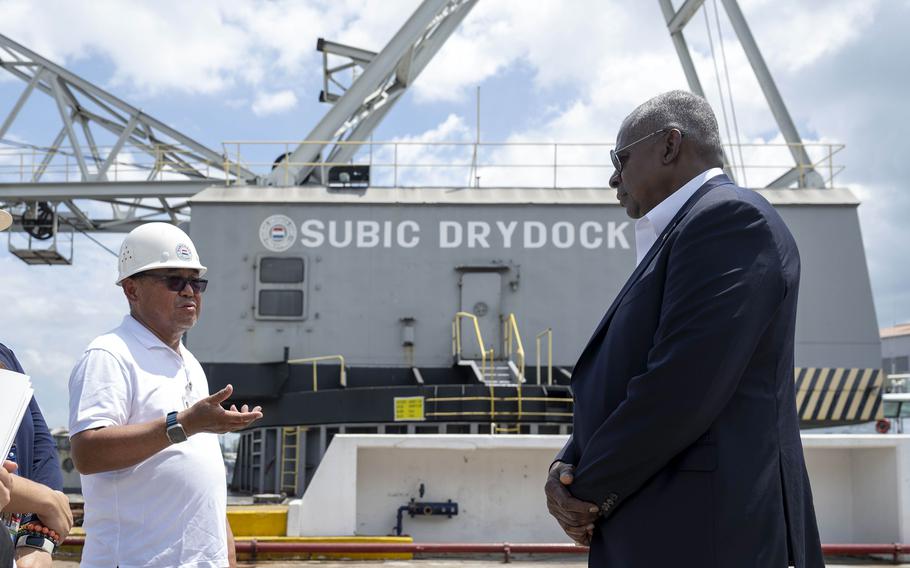
Secretary of Defense Lloyd Austin tours Subic Bay during a visit to the Philippines, July 31, 2024. (Alexander Kubitza/U.S. Navy)
The Philippines wants to reopen parts of Subic Naval Base by 2028 to accommodate its expanding navy, according to the country’s defense minister.
The port and nearby Clark Air Base formed America’s largest overseas military presence before both were damaged in the 1991 eruption of Mount Pinatubo and soon after returned to the Philippines.
The Philippine navy is already using part of the former Hanjin shipyard across the bay from where the naval base stood, but it needs a larger facility, the Philippine Daily Inquirer reported Wednesday.
Manila plans to grow its fleet rapidly as it engages in a test of wills with Beijing over control of stretches of the South China Sea and small islands relatively close to Philippine shores.
China lays claim to nearly the entire sea, including features inside the Philippines’ exclusive economic zone. The two clashed in late August at Sabina Shoal, where Philippine authorities allege a Chinese vessel rammed a Philippine vessel three times.
They also agreed to ease mounting tensions at Second Thomas Shoal, where Filipino marines man an outpost on a grounded, rusting warship.
A process has begun to acquire part of the old naval base, which is administered by the Subic Bay Metropolitan Authority, Philippines Defense Secretary Gilbert Teodoro told a Sept. 24 hearing of the Philippine Senate, according to the Inquirer.
“We have identified an area which is suitable for a main operating base,” he said. “We have gotten presidential approval to pursue the process of acquiring the area and we hope to have it completed by the end of 2028.”
The Philippine navy needs space for new warships, Teodoro said, according to the newspaper.
Aside from Subic, the Philippine navy plans to establish three more forward operating bases in Luzon, the Visayas and Mindanao, the newspaper reported.
In May, Philippine President Ferdinand Marcos Jr. approved a $35 billion plan to modernize the country’s military over the next decade.
“The lion’s share reportedly will be allocated to the Philippine Navy for the allocation of ten corvettes and frigates by 2028 and possibly several conventional submarines,” said Carlyle Thayer, an emeritus professor at the University of New South Wales and a lecturer at the Australian Defence Force Academy.
Even before the modernization plan, Philippine defense officials identified the need for improved naval facilities at Subic Bay, he told Stars and Stripes by email Friday.
The latest plans for Subic make sense given the Philippines’ growing navy, Thayer said.
“Certainly the U.S. Navy would be interested in access to repair and maintenance facilities in Subic Bay,” he said.
Since at least 2012, U.S. submarines and surface vessels have visited Subic on a regular basis, Thayer said.
Reopening the naval base at Subic Bay makes sense, given the tensions with China, former Navy Capt. Jan van Tol, a senior fellow at the Center for Strategic and Budgetary Assessments, a nonprofit defense-policy think tank in Washington, D.C., said by email Sunday.
Most of the Philippine facilities where U.S. forces have access under the 2014 Enhanced Defense Cooperation Agreement are air and ground bases, he said.
However, Van Tol said he doubts the U.S Navy has a plan to base ships in Subic Bay.
“What does make sense from a Philippine perspective, though, given the rising threats from China over Scarborough Shoal and other Philippine claims in the South China Sea, is to improve the facilities at Subic such that they could support Philippine and allied naval operations should that become necessary,” he said.